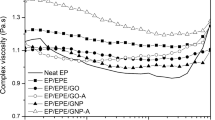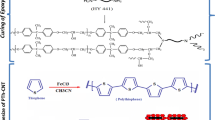Abstract
Poor interfacial adhesion and dispersity severely obstruct the continued development of carbon nanotube (CNT)-reinforced epoxy (EP) for potential applications. Herein, hierarchical CNT nanohybrids using nickel phyllosilicate (Ni-PS) as surface decorations (CNT@Ni-PS) were synthesized, and the nanocomposites derived from varied mass fractions of EP and CNT@Ni-PS were prepared. The morphological structures, tribological performances, curing behaviors and thermal properties of EP/CNT@Ni-PS nanocomposites were carefully investigated. Results show that hierarchical CNT nanohybrids with homogeneous dispersion and well-bonded interfacial adhesion in the matrix are successfully obtained, presenting significantly improved thermal and tribological properties. Moreover, analysis on cure kinetics proves the excellent promotion of CNT@Ni-PS on the non-isothermal curing process, lowering the curing energy barrier steadily.

Similar content being viewed by others
Change history
17 September 2022
An Erratum to this paper has been published: https://doi.org/10.1007/s11705-022-2240-5
References
Liu S, Chevali V S, Xu Z, Hui D, Wang H. A review of extending performance of epoxy resins using carbon nanomaterials. Composites. Part B, Engineering, 2018, 136: 197–214
Wang H, Sun L, Wang R, Yan L, Zhu Y, Wang C, Wang E. Dopamine modification of multiwalled carbon nanotubes and its influences on the thermal, mechanical, and tribological properties of epoxy resin composites. Polymer Composites, 2017, 38(1): 116–125
Esposito L H, Ramos J A, Kortaberria G. Dispersion of carbon nanotubes in nanostructured epoxy systems for coating application. Progress in Organic Coatings, 2014, 77(9): 1452–1458
Li A, Li W, Ling Y, Gan W, Brady M A, Wang C. Effects of silica-coated carbon nanotubes on the curing behavior and properties of epoxy composites. RSC Advances, 2016, 6(28): 23318–23326
Zakaria M R, Akil H M, Kudus M H A, Othman M B H. Compressive properties and thermal stability of hybrid carbon nanotube-alumina filled epoxy nanocomposites. Composites. Part B, Engineering, 2016, 91: 235–242
Li X, Chen B, Jia Y, Li X, Yang J, Li C, Yan F. Enhanced tribological properties of epoxy-based lubricating coatings using carbon nanotubes-ZnS hybrid. Surface and Coatings Technology, 2018, 344: 154–162
Zhou K, Liu J, Shi Y, Jiang S, Wang D, Hu Y, Gui Z. MoS2 nanolayers grown on carbon nanotubes: an advanced reinforcement for epoxy composites. ACS Applied Materials & Interfaces, 2015, 7(11): 6070–6081
Hou Y, Hu W, Liu L, Gui Z, Hu Y. In-situ synthesized CNTs/Bi2Se3 nanocomposites by a facile wet chemical method and its application for enhancing fire safety of epoxy resin. Composites Science and Technology, 2018, 157: 185–194
Bian Z, Kawi S. Preparation, characterization and catalytic application of phyllosilicate: a review. Catalysis Today, 2020, 339: 3–23
Nie S, Jin D, Xu Y, Han C, Dong X, Yang J. Effect of a flower-like nickel phyllosilicate-containing iron on the thermal stability and flame retardancy of epoxy resin. Journal of Materials Research and Technology, 2020, 9(5): 10189–10197
Yang J, Liu Y, Xu Y, Nie S, Li Z. Property investigations of epoxy composites filled by nickel phyllosilicate-decorated graphene oxide. Journal of Materials Science, 2020, 55(24): 10593–10610
Qu J, Li W, Cao C Y, Yin X J, Zhao L, Bai J, Qin Z, Song W G. Metal silicate nanotubes with nanostructured walls as superb adsorbents for uranyl ions and lead ions in water. Journal of Materials Chemistry, 2012, 22(33): 17222–17226
Grassi G, Scala A, Piperno A, Iannazzo D, Lanza M, Milone C, Pistone A, Galvagno S. A facile and ecofriendly functionalization of multiwalled carbon nanotubes by an old mesoionic compound. Chemical Communications, 2012, 48(54): 6836–6838
Burattin P, Che M, Louis C. Characterization of the Ni(II) phase formed on silica upon deposition-precipitation. Journal of Physical Chemistry B, 1997, 101(36): 7060–7074
Zhang X, Zhao D, Luan D, Bi C. Fabrication and mechanical properties of multiwalled carbon nanotube/nanonickel reinforced epoxy resin composites. Applied Physics. A, Materials Science & Processing, 2016, 122(12): 1056
Li H B, Yu M H, Wang F X, Liu P, Liang Y, Xiao J, Wang C X, Tong Y X, Yang G W. Amorphous nickel hydroxide nanospheres with ultrahigh capacitance and energy density as electrochemical pseudocapacitor materials. Nature Communications, 2013, 4: 1894
Kermarec M, Carriat J, Burattin P, Che M, Decarreau A. FTIR identification of the supported phases produced in the preparation of silica-supported nickel catalysts. Journal of Physical Chemistry, 1994, 98(46): 12008–12017
Wu Y, Chang G, Zhao Y, Zhang Y. Preparation of hollow nickel silicate nanospheres for separation of His-tagged proteins. Dalton Transactions (Cambridge, England), 2014, 43(2): 779–783
Da Fonseca M G, Silva C R, Barone J S, Airoldi C. Layered hybrid nickel phyllosilicates and reactivity of the gallery space. Journal of Materials Chemistry, 2000, 10(3): 789–795
Gui C, Hao S, Liu Y, Qu J, Yang C, Yu Y, Wang Q, Yu Z. Carbon nanotube@layered nickel silicate coaxial nanocables as excellent anode materials for lithium and sodium storage. Journal of Materials Chemistry. A, Materials for Energy and Sustainability, 2015, 3(32): 16551–16559
Chabrol K, Gressier M, Pebere N, Menu M J, Martin F, Bonino J P, Marichal C, Brendle J. Functionalization of synthetic talc-like phyllosilicates by alkoxyorganosilane grafting. Journal of Materials Chemistry, 2010, 20(43): 9695–9706
Kim K, Kim Y, Nam J, Baeck S H, Park D W, Shim S E. Mechanical properties of silica-coated multi-walled carbon nanotube/epoxy composites. Polymer (Korea), 2016, 40(1): 117–123
Liu J, Yuen R K K, Hong N, Hu Y. The influence of mesoporous SiO2-graphene hybrid improved the flame retardancy of epoxy resins. Polymers for Advanced Technologies, 2018, 29(5): 1478–1486
Chen X, Wang L, Shi J, Shi H, Liu Y. Effect of barium sulfate nanoparticles on mechanical properties and crystallization behaviour of HDPE. Polymers & Polymer Composites, 2010, 18(3): 145–152
Baptista R, Mendao A, Rodrigues F, Figueiredo-Pina C G, Guedes M, Marat-Mendes R. Effect of high graphite filler contents on the mechanical and tribological failure behavior of epoxy matrix composites. Theoretical and Applied Fracture Mechanics, 2016, 85: 113–124
Yi H, Chen C, Zhong F, Xu Z. Preparation of aluminum oxide-coated carbon nanotubes and the properties of composite epoxy coatings research. High Performance Polymers, 2014, 26(3): 255–264
Yuan J, Zhang Z, Yang M, Guo F, Men X, Liu W. Surface modification of hybrid-fabric composites with amino silane and polydopamine for enhanced mechanical and tribological behaviors. Tribology International, 2017, 107: 10–17
Wang Q H, Zhang X R, Pei X Q. Study on the friction and wear behavior of basalt fabric composites filled with graphite and nano-SiO2. Materials & Design, 2010, 31(3): 1403–1409
Pawlak Z, Kaldonski T, Pai R, Bayraktare E, Oloyede A. A comparative study on the tribological behaviour of hexagonal boron nitride (H-BN) as lubricating micro-particles—an additive in porous sliding bearings for a car clutch. Wear, 2009, 267(5): 1198–1202
Yu J, Zhao W, Wu Y, Wang D, Feng R. Tribological properties of epoxy composite coatings reinforced with functionalized C-BN and H-BN nanofillers. Applied Surface Science, 2018, 434: 1311–1320
Zhao Z, Ji J. Synthesis and tribological behaviors of epoxy/phosphazene-microspheres coatings under dry sliding condition. Advanced Engineering Materials, 2014, 16(8): 988–995
Choi J H, Song H J, Jung J, Yu J W, You N, Goh M. Effect of crosslink density on thermal conductivity of epoxy/carbon nanotube nanocomposites. Journal of Applied Polymer Science, 2017, 134(4): 44253
Dasari A, Yu Z Z, Mai Y W. Fundamental aspects and recent progress on wear/scratch damage in polymer nanocomposites. Materials Science and Engineering R Reports, 2009, 63(2): 31–80
Zhou T, Wang X, Liu X, Xiong D. Influence of multi-walled carbon nanotubes on the cure behavior of epoxy-imidazole system. Carbon, 2009, 47(4): 1112–1118
Singh A K, Panda B P, Mohanty S, Nayak S K, Gupta M K. Study on metal decorated oxidized multiwalled carbon nanotube (MWCNT)-epoxy adhesive for thermal conductivity applications. Journal of Materials Science Materials in Electronics, 2017, 28(12): 8908–8920
Liu Y F, Zhao M, Shen S G, Gao J G. Curing kinetics of tetrabromo-bisphenol—A epoxy resin with diaminodiphenyl methane. Acta Physico-Chimica Sinica, 1998, 14(10): 927–931
Gillham J K. Formation and properties of thermosetting and high Tg polymeric materials. Polymer Engineering and Science, 1986, 26 (20): 1429–1433
Yarahmadi E, Didehban K, Sari M G, Saeb M R, Shabanian M, Aryanasab F, Zarrintaj P, Paran S M R, Mozafari M, Rallini M, et al. Development and curing potential of epoxy/starch-functionalized graphene oxide nanocomposite coatings. Progress in Organic Coatings, 2018, 119: 194–202
Kissinger H E. Reaction kinetics in differential thermal analysis. Analytical Chemistry, 1957, 29(11): 1702–1706
Vyazovkin S, Mititelu A, Sbirrazzuoli N. Kinetics of epoxy-amine curing accompanied by the formation of liquid crystalline structure. Macromolecular Rapid Communications, 2003, 24(18): 1060–1065
Jain R, Choudhary V, Narula A. Studies on the curing kinetics of epoxy resins using mixture of nadic/or maleic anhydride and 4, 4′-diaminodiphenyl sulfone. Journal of Thermal Analysis and Calorimetry, 2007, 90(2): 495–501
Wan J, Gan B, Li C, Molina-Aldareguia J, Li Z, Wang X, Wang D Y. A novel biobased epoxy resin with high mechanical stiffness and low flammability: synthesis, characterization and properties. Journal of Materials Chemistry. A, Materials for Energy and Sustainability, 2015, 3(43): 21907–21921
Friedman H L. Kinetics of thermal degradation of char-forming plastics from thermogravimetry. Application to a phenolic plastic. Journal of Polymer Science Part C: Polymer Symposia, 1964, 6(1): 183–195
Starink M. The determination of activation energy from linear heating rate experiments: a comparison of the accuracy of isoconversion methods. Thermochimica Acta, 2003, 404(1–2): 163–176
Zhang J, Dong H, Tong L, Meng L, Chen Y, Yue G. Investigation of curing kinetics of sodium carboxymethyl cellulose/epoxy resin system by differential scanning calorimetry. Thermochimica Acta, 2012, 549: 63–68
Lu L, Xia L, Zengheng H, Xingyue S, Yi Z, Pan L. Investigation on cure kinetics of epoxy resin containing carbon nanotubes modified with hyper-branched polyester. RSC Advances, 2018, 8(52): 29830–29839
Xu W, Wang X, Liu Y, Li W, Chen R. Improving fire safety of epoxy filled with graphene hybrid incorporated with zeolitic imidazolate framework/layered double hydroxide. Polymer Degradation & Stability, 2018, 154: 27–36
Che Y, Sun Z, Zhan R, Wang S, Zhou S, Huang J. Effects of graphene oxide sheets-zirconia spheres nanohybrids on mechanical, thermal and tribological performances of epoxy composites. Ceramics International, 2018, 44(15): 18067–18077
Kim H, Abdala A A, Macosko C W. Graphene/polymer nanocomposites. Macromolecules, 2010, 43(16): 6515–6530
Acknowledgements
The authors gratefully acknowledge the National Natural Science Foundation of China (Grant No. 51775001), Natural Science Foundation of Anhui Province (Grant No. 1908085J20), University Synergy Innovation Program of Anhui Province (Grant No. GXXT-2019-027) and the Leading Talents Project in Colleges and Universities of Anhui Province.
Author information
Authors and Affiliations
Corresponding authors
Electronic Supplementary Material
11705_2020_2007_MOESM1_ESM.pdf
Synthesis of hierarchical nanohybrid CNT@Ni-PS and its applications in enhancing the tribological, curing and thermal properties of epoxy nanocomposites
Rights and permissions
About this article
Cite this article
Yang, J., Xu, Y., Su, C. et al. Synthesis of hierarchical nanohybrid CNT@Ni-PS and its applications in enhancing the tribological, curing and thermal properties of epoxy nanocomposites. Front. Chem. Sci. Eng. 15, 1281–1295 (2021). https://doi.org/10.1007/s11705-020-2007-9
Received:
Accepted:
Published:
Issue Date:
DOI: https://doi.org/10.1007/s11705-020-2007-9




